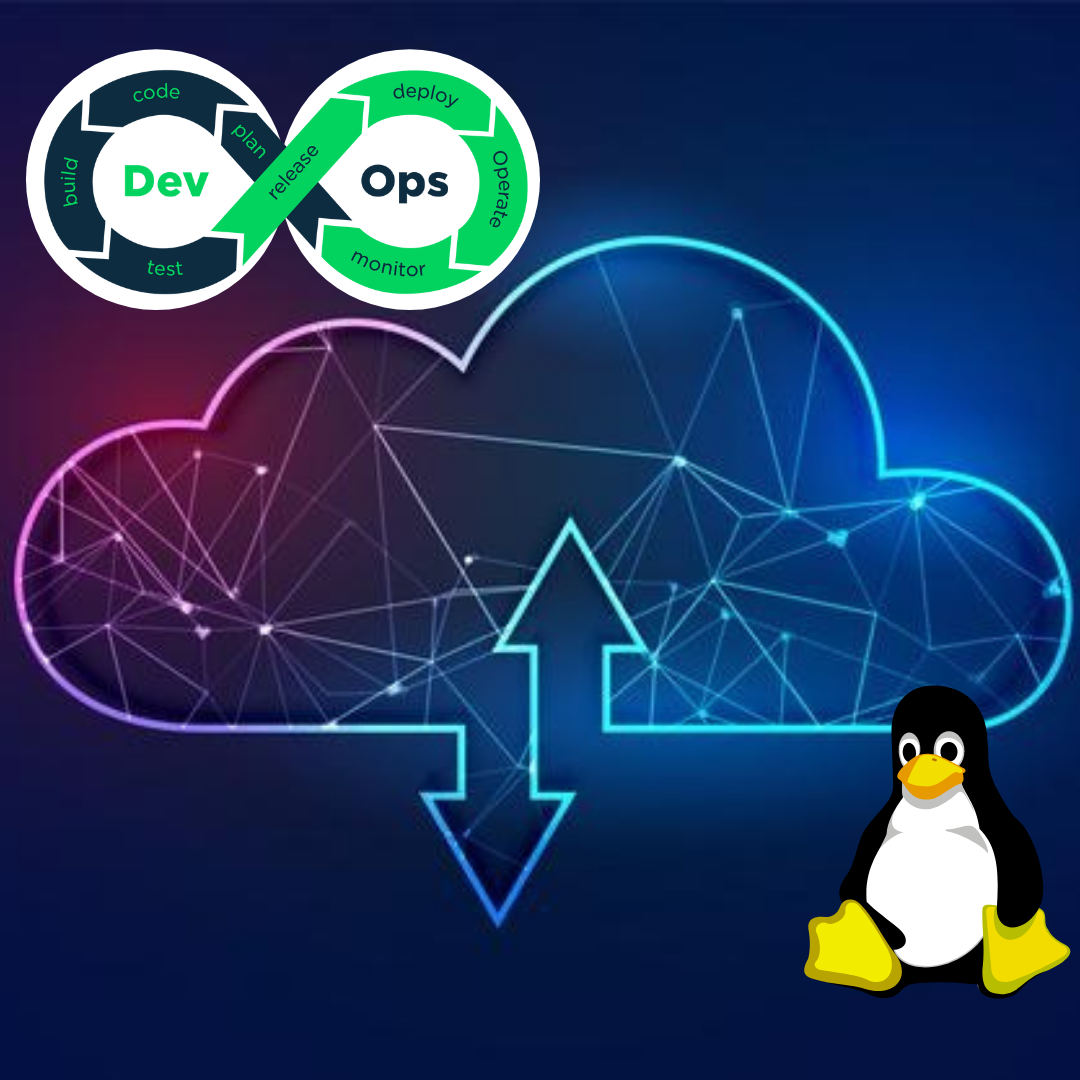Linux for Cloud & DevOps
Linux for Cloud & DevOps
What is Linux for Cloud & DevOps?
We, at Oytie have always tried to focus and work on each and every fields of Information Technology and create great career opportunities. We believe not only giving trainings but also make sure that one has a great career option ahead of a particular course. Oytie is providing string courses in Linux with Cloud & DevOps which is an emerging sector of the of information technology which came in as a boom to the IT sector.

What Is Linux?
Linux is a free open-source Operating System (OS), offered for use under the GNU General Public License (GPL). Linux, like any OS, mediates between the hardware of the machine (CPU, memory, and storage) and its software. The OS manages how the hardware is used to meet the needs of the software.
A Linux-based OS uses a Linux kernel, which is used to manage the hardware resources. A bootloader runs the machine through a startup sequence, and daemons—background services—work in the background to ensure key functions run smoothly. The OS shell, or command line, receive code instructions from the developer and transmits them to the machine.
What Is DevOps?
DevOps is a methodology that unifies software development with information technology (IT) operations. DevOps prioritizes fast software delivery above all else, through the use of automation, integration, continuous collaboration, and open communication.
To maintain a standard level of quality, DevOps teams use Continuous Integration and Continuous Delivery (CI/CD) practices and tools. Continuous Integration (CI) practices improve the codebase is secure through frequent updates, and Continuous Delivery (CD) speeds up the process with automation.
Why You Should Use Linux for DevOps
1. Linux is everywhere
Since its release in 1991, Linux has gained a steady increase in popularity. Today, Linux runs many of the technologies that power up devices and services. From mobile phones, Google applications, social media networks, to GPS services, cloud computing environments, data lakes, Internet of Things (IoT) devices, and Artificial Intelligence (AI) products.
Whether you’re an application consumer or developer, chances are you’re using Linux. According to the 2019 StackOverflow developer survey, Linux is the most loved platform by the surveyed developers, over 25% of which use it as their primary OS. A core goal of DevOps is fast software delivery, and often that means building on existing infrastructure. Linux is a huge part of that.
2. Linux is part of the job
Since DevOps teams share many responsibilities, each role is required to be able to handle challenges as they come. There aren’t any closed-off departments and paper shuffling. DevOps engineer is required to demonstrate skills and knowledge of IT operations, as well as software development.
3. Linux is customizable
The most popular highlight of Linux is its flexibility. You can install it on any device and customize any and every aspect of the OS, from the design of your workflow, from the applications it serves, your DevOps security protocols of choice, and the server environment. This is especially beneficial to DevOps environments, which thrive on a dynamic process.
Software delivery pipelines are often deployed to Linux server environments. If your local machine is Linux-native, you’ll be able to run tests on your device before deploying to the server. Otherwise, you’ll need to test elsewhere and wait for the results. This kind of delay is a thorn in the DevOps machine.
4. Linux is scalable
Scalability is key to the continuity of a DevOps operation. You need to be able to grow without having to change your operating system. To do so would be expensive and time-consuming. Fortunately, Linux is scalable. The Linux kernel can store and process huge amounts of memory, and the requisite hard disk drive (HDD) capacity. You can run it on anything from IoT devices to supercomputers, and keep modifying the OS so it fits your needs.
Enroll today for these courses and let your passion get the idea to develop a bright career.
Red Hat Course Eligibility
Freshers
BE/Bsc Candidates
Any Graduate
Any Post-Graduate
Key features
Flexible schedule
Our Flexibles Schedules allow candidates to start or finish their course when they want.
Interview Preparation
Most important step to land to a job is being prepared for the interview. Oytie provides the environment where one gets the platform to practice and improvise interview skills.
Resume Preparation
Resumes help employers make hiring decisions and help you get your first interview. That’s why it matters how you structure your resume and what information you decide to include.
Live Project Training
Live Project training is important to learn ethics, discipline and working environment of a Company.
Curriculum / Syllabus
Learning materials are important because they can significantly increase student achievement by supporting student learning. For example, a worksheet may provide a student with important opportunities to practice a new skill gained in class.
Syllabus of Linux Course
1st Level – Linux System Administration I
- Getting Started with Red Hat Enterprise Linux
- Accessing the Command Line
- Managing Files from the Command Line
- Getting help in Red Hat Enterprise Linux
- Creating, Viewing and Editing Test Files
- Managing Local Users and Groups
- Controlling Access to Files
- Monitoring and Managing Linux Processes
- Controlling Services and Daemons
- Configuring and Securing SSH
- Analysing and Storing Logs
- Managing Networks
- Archiving and Transferring Files
- Installing and Updating Software Packages
- Accessing Linux File System
- Analysing Servers and Getting Support
- Comprehensive Review
2nd Level – Linux System Administration II
- Improving Command-line Productivity
- Scheduling Future Tasks
- Tuning System Performance
- Controlling Access to Files with ACLs
- Managing SELinux Security
- Managing Basic Storage
- Managing Logical Volumes
- Implementing Advanced Storage Features
- Accessing Network-Attached Storage
- Controlling the Boot Process
- Managing Network Security
- Installing Red Hat Enterprise Linux
- Comprehensive Review
3rd Level – Linux System Administration III
- Introduction Ansible
- Deploying Ansible
- Implementing Playbooks
- Managing Variables and Facts
- Implementing Task Control
- Deploying Files to Managed Hosts
- Managing Large Projects
- Simplifying Playbooks with Roles
- Troubleshooting Ansible
- Automatic Linux Administration Tasks
- Comprehensive Review: Automation with
Ansible
Amazon Web Services (AWS)
- Cloud Service & Deployment Models
- How AWS is the leader in the cloud domain
- Various cloud computing products offered by AWS
- Introduction to AWS S3, EC2, VPC, EBS, ELB, AMI
- AWS architecture and the AWS Management Console, virtualization in AWS (Xen hypervisor)
- What is auto-scaling
- AWS EC2 best practices and cost involved.
- Hands-on Exercise –
Setting up of AWS account, how to launch an EC2
instance, the process of hosting a website and
launching a Linux Virtual Machine using an AWS EC2 instance
- Regions & Availability Zones(AZs)
- Pre-EC2, EC2 instance types
- Comparing Public IP and Elastic IP
- Demonstrating how to launch an AWS EC2 instance
- Introduction to AMIs, Creating and Copying an AMI
- Introduction to EBS
- EBS volume types
- EBS Snapshots
- Introduction to EFS
- Instance tenancy- Reserved and Spot instances
- Pricing and Design Patterns.
- Hands-on Exercise –
1. Launching an EC2 instance
2. Creating an AMI of the launched instance
3. Copying the AMI to another region
4. Creating an EBS volume
5. Attaching the EBS volume with an instance
6. Taking backup of an EBS volume
7. Creating an EFS volume and mounting the EFS
volume to two instances.
Introduction to Elastic Load Balance
- Types of ELB – Classic, Network and Application
- Load balancer architecture
- Cross-zone load balancing
- Introduction to Auto Scaling, vertical and
horizontal scaling, the lifecycle of Auto Scaling - Components of Auto Scaling, scaling options
and policy, instance termination - Using load balancer with Auto Scaling
- Pre-Route 53 – how DNS works
- Routing policy, Route 53 terminologies, Pricing.
- Hands-on Exercise –
1. Creating a Classic ELB
2. Creating an Application ELB
3. Creating an auto-scaling group
4. Configuring an auto-scaling group
5. Integrating ELB with Auto Scaling
6. Redirect traffic from domain name to ELB using
Route 53.
- What is Amazon VPC,
- VPC as a networking layer for EC2,
- IP address and CIDR notations,
- Components of VPC – network interfaces, route tables, internet gateway, NAT,
- Security in VPC – security groups and NACL, types of VPC, what is a subnet, VPC peering with scenarios, VPC endpoints, VPC pricing and design patterns.
- Hands-on Exercise –
1. Creating a VPC and subnets,
2. Creating a 3 Tier architecture with security groups,
3. NACL, Internet gateway and NAT gateway,
4. Creating a complete VPC architecture.
- Introduction to AWS storage
- Pre-S3 – online cloud storage
- API, S3 consistency models
- Storage hierarchy, buckets in S3
- Objects in S3, metadata and storage classes,
object versioning, object lifecycle management, cross-region replication, data
encryption, connecting using VPC endpoint,
S3 pricing. - Hands-on Exercise –
1. Creating an S3 bucket
2. Uploading objects to the S3 bucket
3. Enabling object versioning in the S3 bucket
4. Setting up lifecycle management for only a few objects
5. Setting up lifecycle management for all objects with the same tag
6. Static website hosting using S3.
What is a database, types of databases, databases on AWS
- What is a database, types of databases, databases
on AWS - Introduction to Amazon RDS
- Multi-AZ deployments, features of RDS
- Read replicas in RDS, reserved DB instances
- RDS pricing and design patterns
- Introduction to Amazon Aurora, benefits of Aurora,
Aurora pricing and design patterns - Introduction to DynamoDB, components of
DynamoDB, DynamoDB pricing and design patterns - Hands-on Exercise –
1. Launching a MySQL RDS instance
2. Modifying an RDS instance
3. Connecting to the DB instance from your machine
4. Creating a multi-az deployment
5. Creating a DynamoDB table.
Introduction to CloudFormation
- Introduction to CloudFormation
- CloudFormation components
- CloudFormation templates
- The concept of Infrastructure-as-a-code
- Functions and pseudo parameters
- Introduction to Simple Notification Service, how does
SNS work - Introduction to Simple Email Service, how does SES
work - Introduction to Simple Queue Service, how does
SQS work. - Hands-on Exercise –
1. Creating a CloudFormation stack
2. Launching a t2.micro
3. EC2 instance using CloudFormation
4. Using CloudFormation to automate an architectural
deployment
5. Creating an SNS topic, creating a subscription within topic
6. Setting up SES and sending a mail
7. Creating an SQS queue and sending a sample message.
- Pre-IAM, why access management
- Amazon Resource Name (ARN), IAM
features - Multi-factor authentication (MFA) in IAM,
JSON - IAM policies, IAM permissions, IAM roles,
identity federation, pricing - Introduction to CloudWatch, metrics and
namespaces, CloudWatch architecture,
dashboards in CW, CloudWatch alarms,
CloudWatch logs, pricing and design
pattern - Introduction to CloudTrail, tracking API
usage. - Hands-on Exercise –
1. Creating IAM users and a group
2. creating an IAM policy and attach it to the group
3. creating an IAM role
4. Setup MFA for a user
5. Creating a CloudWatch dashboard and add
metrics
6. Create a CloudWatch alarm which triggers
according to CPU Utilization of an EC2 instance
7. Creating a billing alarm
8. Creating a log group
9. Creating a trail.
DevOps
- Essentials of Cloud Computing?
- Cloud and virtualization architecture
- Cloud Deployment Architecture
- Cloud Providers-An Overview
- Why we need DevOps on Cloud
- Introducing to Amazon Web Services
GIT – A Version Controlling tool
- Knowing about Version control
- Git-A CLI
- Essentials of GIT in Industry
- How to setup GIT
o Installing GIT
o First-time Git Setup
o Getting a Git Repository - Working with Various commands in GIT
- Recording Changes to the Repository
o How to check the status of your files
o How to track New Files
o Staging our modified files
o Ignoring Files from GIT
o Viewing Your Unstaged and staged Changes
o How to commit Your changes
o Skipping the staging Area and commit
o Removing Files from GIT - Viewing the Commit History
o Limiting logs Output
o Using a GUI to Visualize History - Undoing Things
o Changing Your Last Commit
o Unstaging a Stagged File
o Unmodifying a Modified File - Working with Remotes
o Showing Your Remotes
o Adding remote Repositories
o Fetching and Pulling from your Remotes
o Pushing to your Remotes
o Inspecting a Remote
o Removing and Renaming Remotes - Branching and Merging in Git
o What is Branch Is
o Basic in Branching and Merging
o Branch Management in GIT
o Branching Workflows and their usage
o Remote Branches – create and delete
o Rebasing - Git Workflows
- Git Cheat Sheet
- Docker – Overview
- Docker – Container
- Docker – Virtual Machines
- Docker – Engine
- Docker – Architecture
- Docker – Client
- Docker – Storage
- Docker – Networking
- Docker – Installation
- Docker – Installation Docker in Windows
- Docker – Container and Image
- Docker – Implementation Example
- Kubernetes-Introduction
- Kubernetes Cluster Architecture- An Overview
- Understanding Concepts of Pods, Replica sets,
deployments and namespaces - Understanding the concepts of services and networking
- Persistent volumes and persistent volume claims-an overview
- Design of Pods
- Understanding labels, selectors, jobs and schedulers
- Essentials of Continuous Integration
- An Example scenario where CI is used
- Know about Jenkins and its architecture in detail
- Jenkins tool management in detail
- Know about User Management in Jenkins
- Authentication
o Jenkins own database user creation
o Options to enable integration with LDAP - Authorization
o Matrix-based authorization
o Project-based authorization - Overview of Maven
o Maven project structure
o Maven plugin
o Project Object Model(POM)-fundamental unit of work in Maven project
o Maven Build LifeCycle
o Adding External dependencies to maven pom.xml
o Maven build and test project - Creating jobs and automatic build settings
o What is Jenkins Pipeline?
o Why Pipeline? -
Integration with GIT
o How to enable project-based authorization for a job
o Source code management while creating jobs
o Triggering an automated build
o Maven job setup
o Know about post-build options for jobs like notifications, triggering another build, publishing reports, etc -
Adding a slave node to Jenkins
-
Building Delivery Pipeline
-
Notification settings in Jenkins
-
Plugin management in Jenkins
- Introducing Ansible – A Configuration
management Tool
o Basics
o Installation
o Understanding Ansible Architecture
o Control Machine Requirements
o Managed Node Requirements - Inventory
o Host and Groups
o Host Variables
o Group Variables - Learn various ansible Modules
- How to use adhoc commands
o Parallelism and Shell Commands
o File Transfer
o Managing Packages
o Users and Groups
o Deploying from Source Files
o Managing Services - Introduction to YAML script
- Playbook
o About Playbooks
o Playbook language Example-YAML
o How to write Playbooks
o Task in Playbooks
o Understanding about various tasks in playbook
o Introduction to Handlers and variables
o Learn about using handlers, variables in the playbook
o Become(Privilege Escalation) - Roles
o Role Directory Structure
o Using Roles
o Role Duplication and Execution
o Role Default Variables
o Role Dependencies
o Role Search Path
o Ansible Galaxy - Including and Importing
o Includes vs Imports
o Importing Playbooks
o Including and Importing Task Files
o Including and Importing Roles
- Introduction to Grafana
o Getting Started
o Basic Concepts
o Screencasts
o Grafana and other tools - Grafana Installation
o Installing on Ubuntu/Debian
o Installing on Centos/Redhat
o Installing using Docker
o Building from Source
o Upgrading - Grafana Administration
o Configuration
o Security
o Authentication
o Permissions
o Grafana CLI
o Internal metrics
o Provisioning
o Troubleshooting - Grafana Features
o Panels
o Dashboard Features
o Data Sources
o Explore
o Alerting
o Keyboard Shortcuts
o What’s new in Grafana? - Grafana Integration
o Running Grafana behind a reverse proxy
o Create API Tokens and Dashboards
o Grafana with IIS Reverse Proxy on Windows
o How to integrate Hubot and Grafana
o Setup Grafana for High availability - Grafana Plugins
o Installing Plugins
o Developing Plugins - Grafana HTTP API
o Admin
o Alerting
o Alerting Notification Channels
o Annotations
o Authentication HTTP API
o Dashboard
o Dashboard Permissions
o Dashboard Versions
o Data Source
o Data Source Permissions
o External Group Sync
o Folder
o Folder/Dashboard Search
o Organization
o Playlist
o Preferences
o Snapshot
o Teams
o User
Batch Schedule
Students Reviews & Testimonials
Some Happy Faces from Our Recent Batch




Some of our Recruitment partners








Previous
Next
Career Opportunities
Linux Engineer
Pune, India
Linux Administrator
Mumbai, India
DevOps Engineer & Admin
Mumbai, India
DevOps Engineer
Pune, India
Linux Admin
Bangalore, India